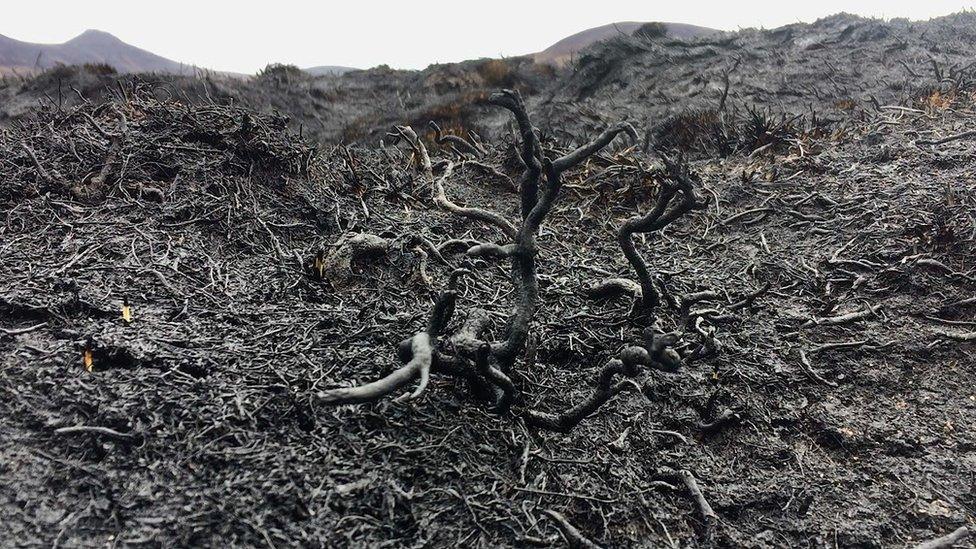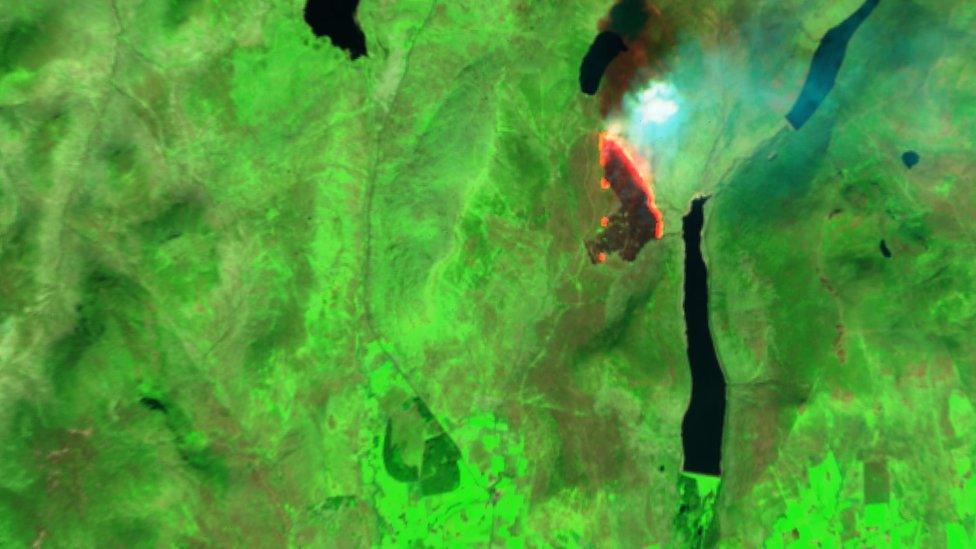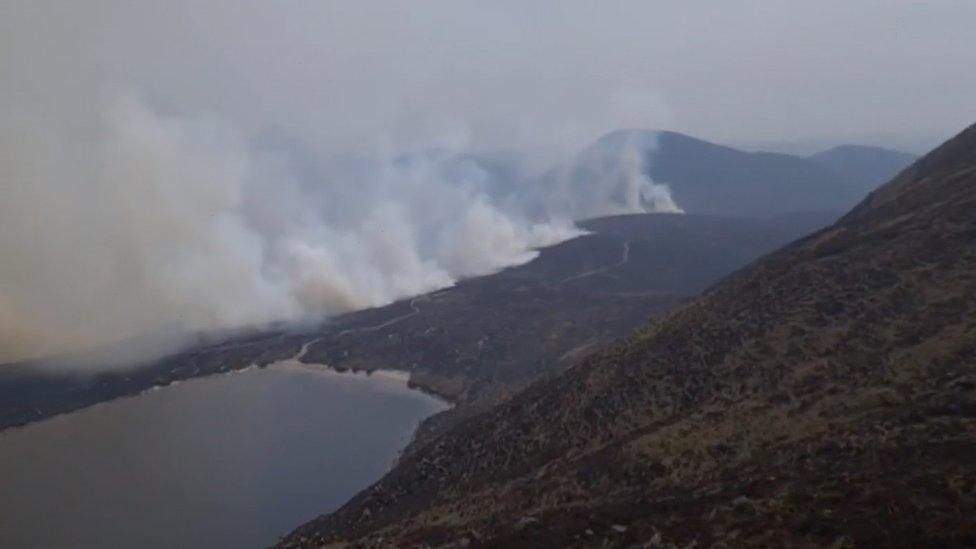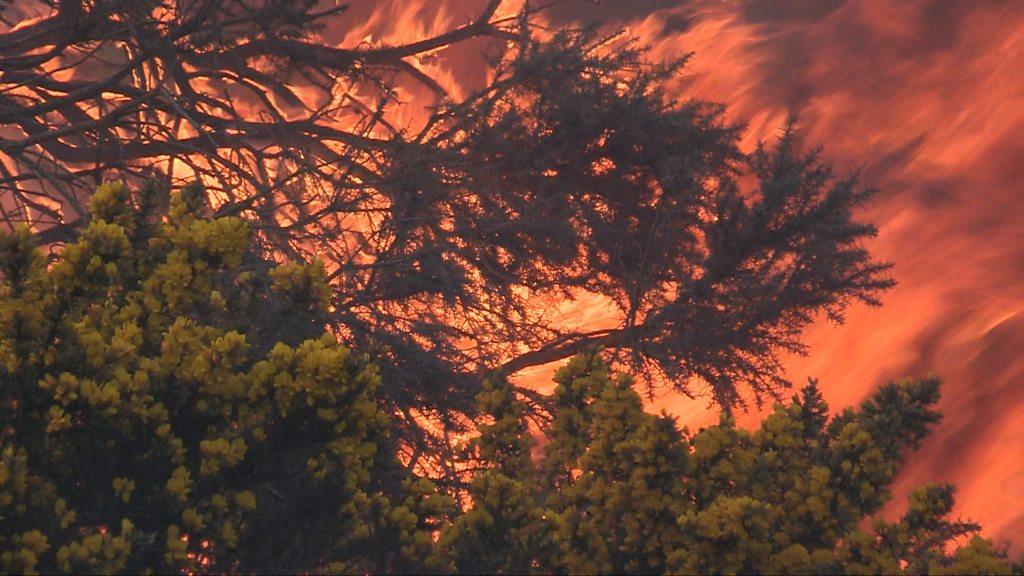Spate of wildfires cause major environmental damage
- Published

There have been at least 300 wildfires in NI since the start of April
A 24-hour fire in a protected part of the Mourne Mountains gave off carbon equivalent to the annual emissions of 150 cars, experts have said.
It caused significant damage to about a square kilometre of blanket bog habitat, which is an important carbon sink.
It is estimated that up to 300 tonnes of carbon was released, contributing to climate change.
The fire service believes the incident was started deliberately.
Ecologists say while heather grows back, a huge amount of plant, insect and animal biodiversity is lost as a result of wildfires in peatland habitats.
There have been at least 300 wildfires in NI since the start of April.
A number of them have been on sites designated for their environmental importance.

The Murrins is protected as an Area of Special Scientific Interest
A fire at the Murrins near Loughmacrory, County Tyrone, seriously damaged landscape which dates back 15,000 years to the last Ice Age.
It has been protected as an Area of Special Scientific Interest, as an expansive peatland with a rich diversity of plant life.
Agriculture and Environment Minister Edwin Poots confirmed up to 150 hectares of the Murrins was affected and it could take years to recover.
Conor Graham, a mapping expert who works in the Geography Department of Queen's University, used satellite imagery to assess the damaged area in the Mournes.

Satellite imagery has helped researchers understand the scale and damage caused by the fires
"There's a lot of carbon stored in the peat and when we fire it, a lot of it can be released into the atmosphere," Mr Graham said.
"Different types of bog have different amounts of carbon in it, but we can do rough estimates.
If we look at some of the metrics we have for carbon, we think about 300 tonnes of carbon would have been released in this event.
"And obviously that carbon will contribute to climate change."

Dr Neil Reid warned an area's biodiversity can permanently change after fires
Dr Neil Reid is a senior lecturer in conservation biology at Queen's University, who has reported on the impact of wildfires on peatland.
He says a high percentage of wetland specialist plants and invertebrates can be permanently lost after such burns, changing the area's biodiversity.
"It's not just the plants, the spiders and beetles which are wetland specialists, they disappear and are replaced by generalists, beetles and spiders that like drier conditions and that are common elsewhere, so you get this diminution of biodiversity and as a result bird biodiversity decreases as well.
"So the peatlands, while they look as if they are recovering because the heather is there, have in fact lost a huge array of their diversity from mosses, beetles, spiders, birds plants ,throughout the entire system."
Sanctions
There are sanctions for causing wildfires at protected sites, fines of up to £20,000 for the landowners and £2,500 for anyone else.
But it is a difficult crime to prove and successful convictions are few, leading to calls for a review of the legislation.
Sinn Féin chairman of the environment committee, Declan McAleer, who helped the community tackle the fire at the Murrins, said it may be time to revisit the legislation to create a stronger deterrent.
Peat bogs store huge amounts of carbon and are created by layers of decaying vegetation.
It can take up to 50 years to create one square metre just a single centimetre deep and our blanket bogs that store hundreds of thousands of tonnes of carbon have taken thousands of years to generate.
Northern Ireland's annual carbon emission is estimated to be about 20m tonnes.
- Published27 April 2020
